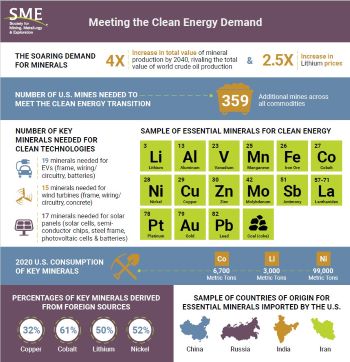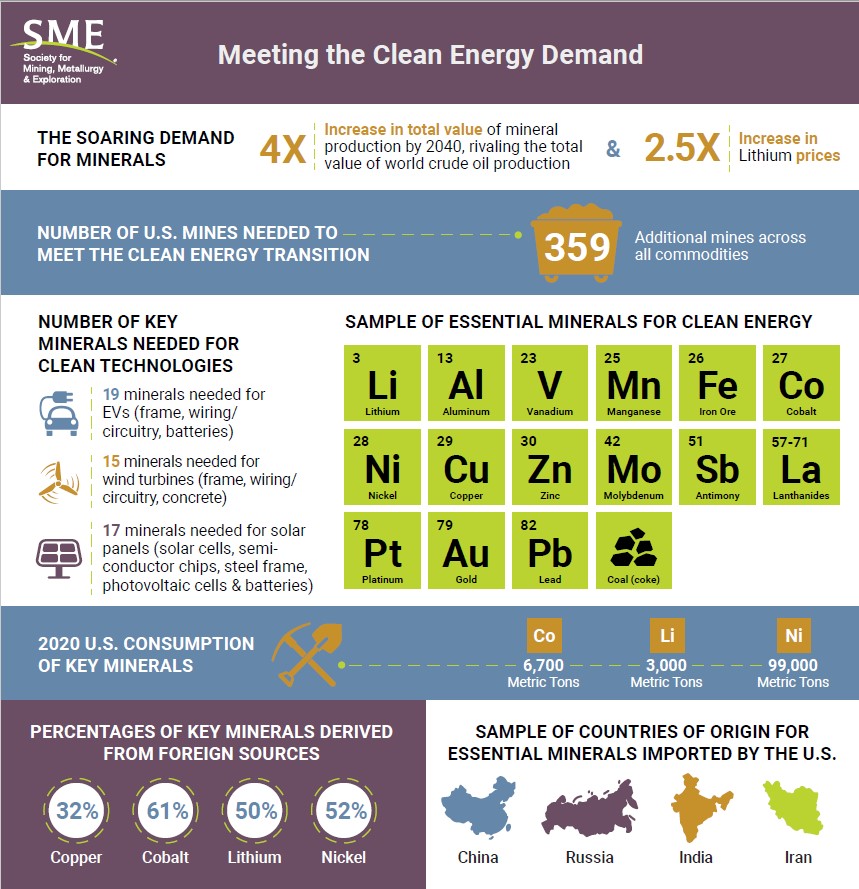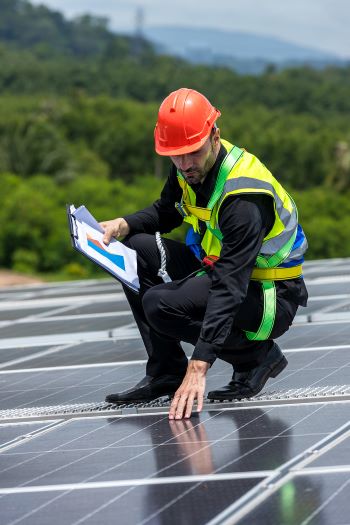The United States runs on energy and clean energy runs on minerals. Critical minerals are required for all the major energy technologies of the future, including solar, wind, and electric vehicles (EVs). But rising costs and the lack of domestic supplies for these minerals are delaying the nation’s transition to the Green Economy. We estimate that the limited availability of four key minerals — copper, nickel, cobalt and lithium — will negatively impact the U.S. economy within five years.
We need to act now if we are to stay on track for a sustainable future.
Learn about the central role of minerals in the Green Economy.
By the Numbers: The Soaring Demand for Minerals
- 6X Increase in demand for minerals by 20401
- 3 Billion Increase, in tons, in demand for minerals by 20402
- 70-90% Increase in demand for nickel, cobalt and lithium by 20403
Green Economy Policies Drive a Massive Surge in Demand for Minerals
- The Inflation Reduction Act (IRA) of 2022 marks the single largest investment in climate and energy in American history.
- At least $25.7 billion in new U.S. clean energy factories are in the works as a result of subsidies in the landmark climate law.
- The California Effect: The state’s Zero-Emission Vehicle Program requires that 100% of new cars and light trucks sold in California be zero-emission EVs by 2035. The impact of this rule will ripple across the nation.
The Green Economy Depends on Sustainable Access to Key Minerals
The U.S. does not mine most of the minerals we need for clean technologies. Instead, the nation currently imports most of our critical mineral commodities. This creates strategic vulnerabilities for economic prosperity and national security, as the U.S. remains dependent on unstable or adversarial nations for our supplies.
In addition, ensuring responsible mining practices is essential to building the Green Economy. The U.S. has the safest and cleanest mining industry in the world, due to the National Environmental Policy Act of 1969 (NEPA) and the Surface Mining Control and Reclamation Act of 1977 (SMCRA). By contrast, foreign sources of minerals like copper, nickel, cobalt and lithium often depend on destructive and unsustainable mining processes.
As the demand for renewable energy and sustainable technologies continues to increase, so too will the demand for critical minerals. If we continue to limit our access to these key commodities, the prices we pay and the competition we face could hit historical highs, impacting the nation’s transition to the Green Economy.
We support a number of measures that would allow the U.S. to secure a domestic supply of key minerals and catalyze the clean industries of the future, including:
- Streamlining the permitting process to eliminate duplicative state and federal agency oversight
- Currently, it takes more than 10 years for a mine to receive all the necessary authorizations to begin extraction and production.
- Increasing investments in domestic mines to help end our nation’s import reliance
- ESG investments in mines are critical to meeting the clean energy demand.
- Expanding the number of mines across most commodities
- Due to supply constraints and growing consumption, prices increase for many commodities without the proper resources.
References
1 National Mining Association (NMA) estimate
2 IMF estimate
3 NMA estimate
4 International Monetary Fund (IMF) estimate
5 International Monetary Fund (IMF) estimate
6 As estimated by the 2020 USGS report; this number could be slightly smaller or larger, depending on the size of deposit and grade of each mineral deposit mine site.
7 USGS Report of US Minerals Net Import Reliance, 2020



